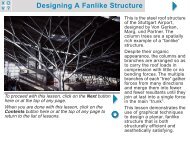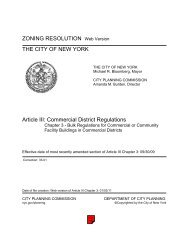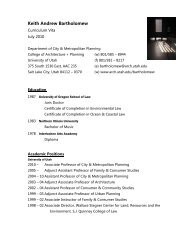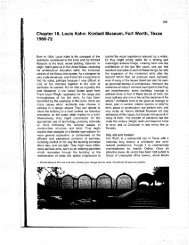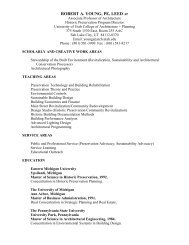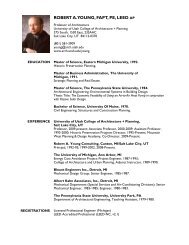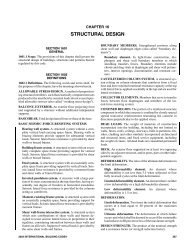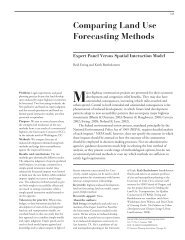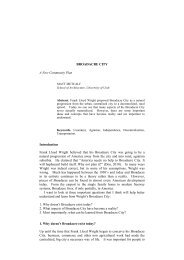The Josephine Baker House: For Loos's Pleasure Farčs el-Dahdah ...
The Josephine Baker House: For Loos's Pleasure Farčs el-Dahdah ...
The Josephine Baker House: For Loos's Pleasure Farčs el-Dahdah ...
You also want an ePaper? Increase the reach of your titles
YUMPU automatically turns print PDFs into web optimized ePapers that Google loves.
floor of a building, and sometimes in the ba~ement)."~' Back<br />
in the vestibule, the sequence continues and another escalier<br />
leads to the next floor where one finds the salle a manger<br />
separate from the rest of the apartments.<br />
It may not seem so strange to approximate <strong>Loos's</strong> modernist<br />
house with an eighteenth-century precedent once we realize<br />
that its planimetric distribution not only corresponds to that<br />
of an hbt<strong>el</strong>, but also evokes the "affections of the soul" that<br />
an eighteenth-century architectural theorist would call on<br />
when distributing a plan. This distribution of pleasure is<br />
evident as soon as one walks in the <strong>Baker</strong> <strong>House</strong> and con-<br />
fronts the large, overscaled stairs that could easily b<strong>el</strong>ong to<br />
the Folies Btrgdres. <strong>The</strong> cabaret audience, now reduced to a<br />
single spectator, stands at the entrance looking up. <strong>The</strong><br />
stairs are so long that the anticipated approach of <strong>Josephine</strong><br />
from the vestibule can, at first, only be heard. Her head or<br />
coiffure soon appears and the rest of her body is gradually<br />
revealed, from top to bottom, just as in a striptease, lest we<br />
forget that the American dancer had been imagined stripped<br />
of all her clothes/ornaments. <strong>Josephine</strong> must now "wear"<br />
the stairs, much as she would a dress, in order to play the<br />
stripteaser's subtle game of concealing and revealing. In the<br />
vestibule above and down the stairs, she is imagined danc-<br />
ing forward and backward, teasing and manipulating the<br />
spectator b<strong>el</strong>ow.<br />
<strong>The</strong> framing of motion in the perspectival volume of the<br />
staircase is the architectural equivalent of E. J. Marey's<br />
"chronophotography" as the capturing of a moving object in<br />
a single frame. In a similar way, the stairs become a literal<br />
apparatus that depicts the dancer's nude body in various<br />
points much as in Marc<strong>el</strong> Duchamp's Nude Descending<br />
Staircase. This "demultiplification," to use Duchamp's<br />
term, inspires a kind of reverie that r<strong>el</strong>ativizes time and<br />
space, transforms absence into presence, and becomes a<br />
scenographic mechanism that anticipates capturing the<br />
motion of <strong>Josephine</strong> dancing up and down the stairs.j2 <strong>The</strong><br />
voyeur thus architecturalizes an unconventional mode of<br />
representation in order to transcend <strong>Josephine</strong>'s absence.<br />
<strong>The</strong> house momentarily becomes a photographic apparatus<br />
of "instantaneityn through which "the object is complet<strong>el</strong>y<br />
stretched out as if <strong>el</strong>astic," stretched far enough that it might<br />
be touched.33<br />
Another voyeuristic scenario has already been pointed out<br />
wherein the house's inhabitant "is now the primary object<br />
[of vision], and the visitor, the guest, is the looking subje~t."~~<br />
This occurs in the low passages that provide a place<br />
from which to view into a swimming pool that is dived into<br />
from the bedroom floor above. From these passages one<br />
looks through "transparent windows . . . so that it was possible<br />
to watch swimming and diving in its crystal clear<br />
water, flooded with light from above." This scenario transforms<br />
the window into "a miniature entertainment center,"<br />
borrowed in principle from the maison close (broth<strong>el</strong>) Loos<br />
and his generation, no doubt, freq~ented.~~ <strong>The</strong> origin of<br />
such a voyeuristic practice, we are told, lies the nineteenth<br />
century when the sexual act was abandoned in favor of a<br />
visual orgasm:<br />
Broth<strong>el</strong>s began to provide the tableau vivant; in the grand salon<br />
a kind of erotic machinery is set up by the Madame. On a large<br />
black carpet, naked girls, were seated in suggestive poses, lit by<br />
cand<strong>el</strong>abras; on a rotating floor, women appeared with airs of<br />
wax dolls eternally fixed in voluptuous poses. <strong>The</strong> spectator,<br />
seated in an armchair, could watch and enjoy the scenes in the<br />
room next door.j6<br />
<strong>The</strong> voyeur's window is not unlike <strong>Loos's</strong> clean white wall<br />
that is suddenly daubed with desire. Loos defines the window<br />
as that which serves "to let the light in, not to let the<br />
gaze pass through"; yet here he designs windows that serve<br />
precis<strong>el</strong>y "to let the gaze pass thro~gh."~' If, indeed, "a cultivated<br />
person never looks out of the window," for it is improper<br />
to stare, in <strong>Josephine</strong>'s house the window has been<br />
pushed inward, doubled along the facade, so that <strong>Loos's</strong><br />
modern and distinguished man can do what he is not supposed<br />
to: he can r<strong>el</strong>ease his desire to stare into the exact<br />
space where his gaze is forbidden. <strong>The</strong> act of refraining to<br />
look out occupies the place where the voyeur endlessly<br />
stares through the window on the side of the pool. He looks<br />
while being framed by a window behind him on the house's<br />
facade and from which he is not to look out. <strong>The</strong> window<br />
that does let the gaze pass through opens onto an aquatic<br />
world in which the naked body of <strong>Josephine</strong> might dive at<br />
any moment. So he waits and paints his affects on the tableau<br />
in front of him as a discourse of absence, if not of abstinence.<br />
<strong>The</strong> window thus becomes a tableau of <strong>Loos's</strong> own<br />
desires: "a pure projection, sharp-edged, incorruptible, irre-



